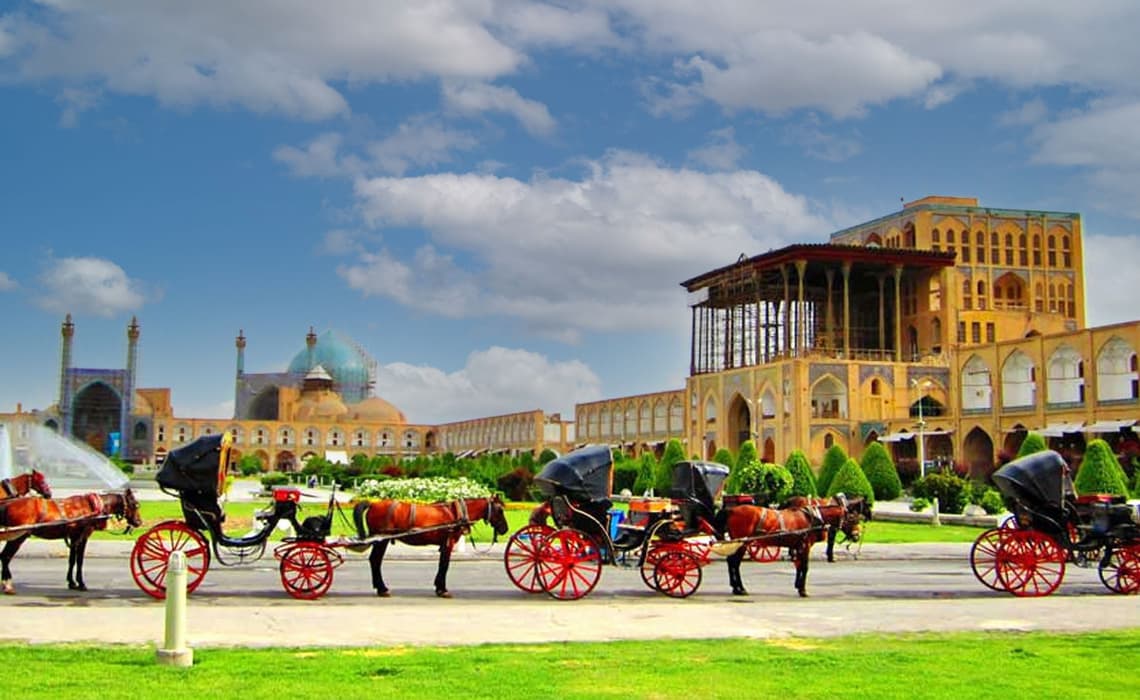Sheikh Lotfollah Mosque has been built in the eastern part and side of Naqshe- Jahan Square. This mosque was built by the order of Shah Abbas I, which started in 1011 and ended in 1028
Master Mohammad Reza Isfahani was in charge of the architecture of this mosque and Alireza Abbasi, the famous calligrapher of the Safavid era, wrote the inscription on it in the third line.
Many masters used to live during that era. Many houses and buildings were built around this place. One of them is the Kianpour house accommodation in Iran; which is serving as a traditional hotel in Iran now.
Shah Abbas built this mosque to thank his father-in-law, Sheikh Lotfollah, who was one of the great Shiite scholars and the people of present-day Jabal Amel and Lebanon. Next to this mosque, a school was built for Sheikh Lotfollah to teach, which was unfortunately destroyed. Sheikh Lotfollah Mosque, although it does not have a minaret and a courtyard, but it has a large dome that few architectures have examples like this.
In 1020 AH, by the order of Shah Abbas I, thee construction of the Abbasi Grand Mosque began and in 1025 the construction of the mosque was completed. The decoration of the mosque began in 1025 and continued when two of Shah Abbas' successors were present. Professor Ali Akbar Isfahani was in charge of the architecture of the mosque and Alireza Abbasi was in charge of the calligraphy of the inscription on it. In the southwestern part of the school, a piece of stone is placed at a certain point, which shows the exact noon of Isfahan in all seasons. These calculations are attributed to Sheikh Baha'i. Another feature of this mosque is the echo of sound under the big dome of the mosque. Its height reaches 52 meters.
Aali-Qapu Palace or Deloletkhaneh Palace
The Aali-Qapu palace, known as the Palace of the State, it was built during the Safavid era by order of Shah Abbas I. it consists of five floors, each of which has its own unique decoration. Reza Abbasi, the famous painter of the Safavid era, painted beautiful miniatures on the walls of the palace, very special and dazzling bedspreads that doubled the beauty of the palace, especially the bedding of the sound room, which has acoustic properties, because when playing a song, it played harmoniously and without creating echoes.
During the reign of Shah Abbas II in 1054, a hall with grandeur and beauty was added to this palace and the beauties of the palace became more attractive and complete. Shah Abbas and his successors in this palace, from their high-ranking guests and ambassadors. They were entertaining. From the upper part of this palace, you can see the city of Isfahan with a great view. According to the sayings: The reason for naming Qapu is that the entrance door of this palace was brought from Najaf Ashraf, but in another narration. This name is derived from the Ottoman Bab al-'Ali. A chain hung on the door of this palace that people were safe from any aggression when they took refuge in it and no one had the right to attack them except the king himself.
In addition to the existing buildings, there are various other buildings in Naqshe- Jahan Square that have lost their use and properties over time and have been destroyed. For example, it can be said that the clock mansion has been completely destroyed and the building of Sheikh Lotfollah Mosque has been replaced and constructed and the majestic capitals that probably reached Isfahan from Persepolis (one of which was transferred to Chehelston and the other is located in the Iran Basta Museum), 110 Spanish cannons (The spoils of the conquest of Hormoz Island by Imam Qoli Khan) and the forty-meter-high Qapu bar in the center of the square (which is completely destroyed today) are among them.







